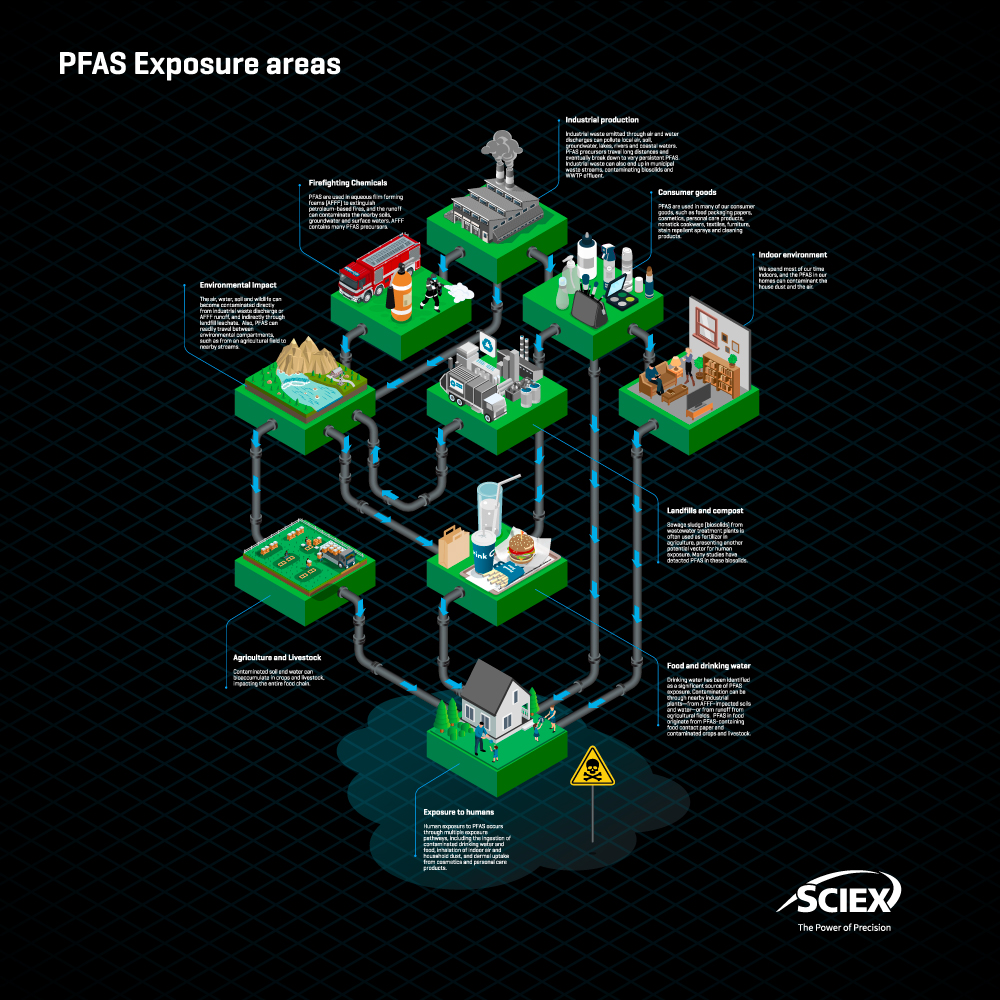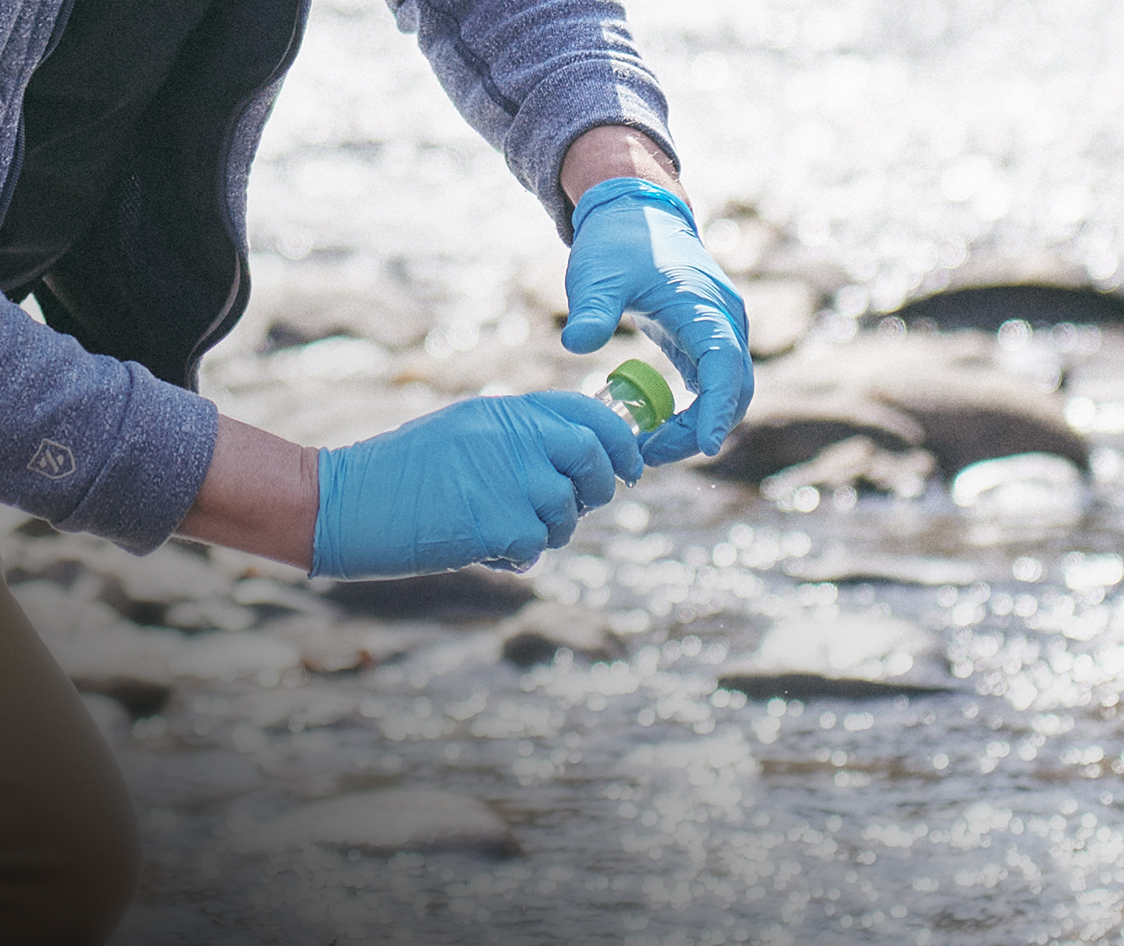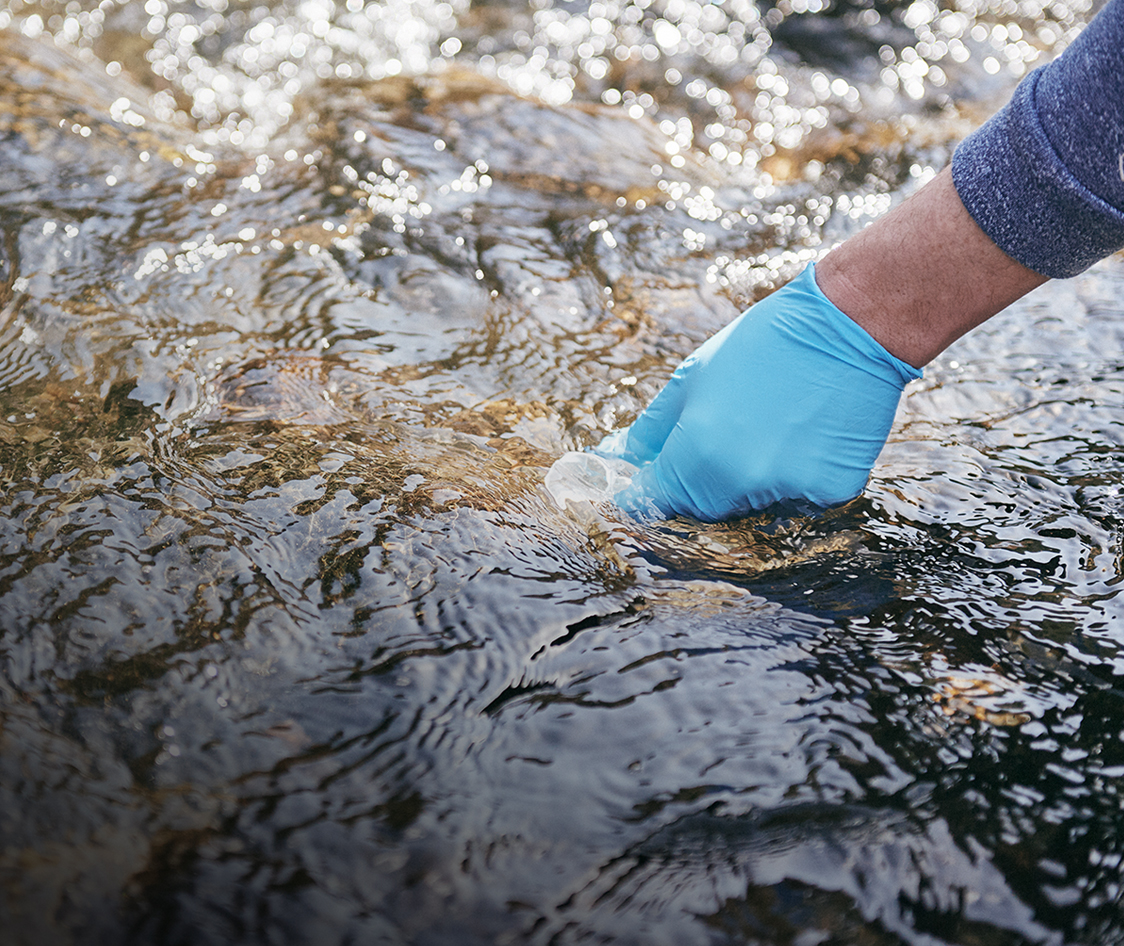SCIEX 7500 system
For ultimate quantification of trace level PFAS compounds, the SCIEX 7500 system is the instrument of choice. The sensitivity gains reduce the need for concentration steps in sample preparation.
The analysis of poly-and perfluoroalkyl substances (PFAS) is now a regular test conducted across many environmental laboratories around the globe. The prevalence of PFAS compounds in environmental samples require an end to end workflow that is highly sensitive to quantify at parts per quadrillion levels (ppq), free from the spoils of contamination throughout the method, produces consistent, precise, and reliable results from injection to injection.
The demand for PFAS testing of drinking water, raw water, and soil (just to name a few) is expanding. PFAS testing needs are now migrating outside of the typical matrices found in environmental analysis to food products, animal tissues, human biological fluids. Therefore, depending on the type of analysis your laboratory performs, the chosen workflow must be adaptable and robust to analyze various sample types for PFAS.
Download PFAS lifecycle


PFAS workflows
April 2024 saw the final announcement from the EPA announcing the National Primary Drinking Water Regulation, stating the Maximum Contaminant Level (MCL) for six PFAS compounds in drinking water. Collaborating with industry experts, the SCIEX PFAS team are constantly challenging the status quo on the best PFAS applications our instruments can offer to our users, as evidenced by the technical materials and scientific knowledge presented here. Keep scrolling and discover what SCIEX offers, and ask us about more PFAS-related materials.
The Superfund law then designated PFOA and PFOS as hazardous substances under the Comprehensive Environmental Response, Compensation, and Liability Act (CERCLA), coinciding with a few regional regulations updates: such as the European Union (EU) and the state of New York banning PFAS in food packaging, and New Zealand banning PFAS in cosmetics.
One of the first major announcements by the US EPA focused on advisory levels for PFAS in drinking water, including contaminants such as Perfluorooctanoic acid (PFOA), Perfluorooctanesulfonic acid (PFOS), GenX (HFPO-DA) chemicals, and Perfluorobutanesulfonic acid (PFBS). The original proposal called for Health Advisories (HAs) as low as 4 parts-per-quadrillion (PPQ), which our internal SCIEX PFAS experts were the first to deliver a working method for this application using highly sensitive LC-MS/MS instrumentation.
Since then, a number of government-led guidelines have been announced to regulate these environmental pollutants and safeguard against potential harm due to human exposure. The European Chemicals Agency (ECHA) led with their universal PFAS restriction proposal covering a wide-range of commercial products containing this family of chemicals.




For ultimate quantification of trace level PFAS compounds, the SCIEX 7500 system is the instrument of choice. The sensitivity gains reduce the need for concentration steps in sample preparation.
With thousands of PFAS compounds out in the environment, and materials used in all aspects of daily life, the SCIEX 7600 system delivers comprehensive discovery workflows to detect and characterize new compounds of interest.
This verified library contains spectra for 96 flurorochemicals and their metabolites commonly tested in environmental samples, enabling you to easily create methods and processes for targeted and non-targeted screening on your complex samples. (v2.0 has about 250 compounds, with the addition of many AFFF-derived compounds)
Technical Note
In this method sub-parts per trillion (ppt) levels of detection for 26 PFAS compounds was achieved with LOD values of 0.2 ng/L in diluent and calculated method detection limits in drinking, ground, and surface water ranging between 0.06 ng/L and 1.12 ng/L.
Technical Note
A collaborative exploration of instrument sensitivity and sample preparation for ultra-trace analysis of PFAS on the SCIEX 7500 system.
Interactive map
Dive into our interactive map showcasing tap water samples tested for PFAS compounds across the U.S., powered by data from SCIEX and Eurofins. See how “forever chemicals” like PFOA and PFOS appear in everyday drinking water—and what that means for us all.
Data Gallery

Achieve reporting limits of 2ng/L with excellent linear dynamic range and support your EPA 533 and UCMR5? requirements

Detect 14 PFAS compounds in drinking water with EPA Method 537.1 guidelines in just 10 minutes

Meet regulatory limits by characterizing and quantifying PFAS and GenX in water using liquid chromatography-mass spectrometry.
Get the tools and protocols you need for fast, robust and accurate quantification of trace PFAS levels in drinking water
Download the beginners guide to detect, quantify and identify PFAS and GenX compounds with confidence
Liquid chromatography-tandem mass spectrometry (LC-MS/MS) technology paves the way in analytical science to test for known and unknown poly- and perfluoroalkyl substances (PFAS) in drinking water, wastewater, and soil. The sensitivity and robustness of LC-MS/MS make it an ideal choice to analyze these ubiquitous and persistent pollutants quantitatively.
It's remarkable quantitative PFAS refers to a group of synthetic chemicals, such as perfluorooctanoic acid (PFOA) and perfluorooctanesulfonic acid (PFOS), and many other substances. PFAS testing is important because more than 3,000 types of PFAS threaten human health and the environment. These chemicals have been present in commercial production since the 1940s to make surfaces in products such as aqueous film-forming foams (AFFF), non-stick kitchenware, and adhesives resistant to water and grease.
When it comes to PFAS analysis, its important to adopt best practices that minimize the potential for system contamination while successfully measuring PFAS at trace levels in various matrices such as water, soil, and even food.
LC-MS/MS is ideal for monitoring PFAS in environmental samples due to its:
LC-MS/MS has transformed the path to detecting, quantifying, and understanding PFAS. At SCIEX, we understand your lab is challenged with high sample volume and impending deadlines, and unreliable instrument systems are just unacceptable. Whether your laboratory needs to identify new PFAS or routinely quantify them, PFAS testing with LC-MS/MS solutions from SCIEX will help you maximize productivity, while consistently providing you with the high-quality data you need.
Our sister company Phenomenex provides all the required consumables and resources for PFAS testing, from Stacked Solid Phase Extraction solutions to optimized LC columns PFAS section
Check out these additional PFAS resources from Phenomenex:
Resources
This technical note describes the analysis of per- andpolyfluoroalkyl substances (PFAS) in textiles using the SCIEX 6500+ system.
Quantitation of PFAS at ultra-trace levels is required to safeguard drug product quality and patient safety. This technical note demonstrates a sensitive quantitation method for PFAS using the SCIEX 7500+ system.
This technical note describes a direct injection LC-MS/MS method for the simultaneous quantitation of ultrashort-, short-and long-chain per- and polyfluoroalkyl substances (PFAS). in water. Mixed-mode chromatography demonstrated robust retention and separation for the wide range of PFAS chain lengths tested.
This technical note demonstrates the use of the PromoChrom automated solid-phase extraction (SPE) system for the analysis of PFAS in drinking water following EPA Method 533. Using the SCIEX QTRAP 6500+ system, negligible background contamination was observed as well as excellent method performance in spikes into reagent water and raw untreated groundwater samples.
Because of the pervasive nature of PFAS and the suggested PFAS detection limits continuingly being decreased in environmental sample analysis, there is an increasing need to have LC-MS strategies that can effectively manage PFAS background. Here, a workflow was established on the ExionLC 2.0 system with the optional wash system using delay columns to separate background PFAS contamination from sample analysis. An assay for 52 PFAS analytes was used to characterize the performance attributes of the LC system, including carryover. Analysis was performed using the SCIEX Triple Quad 7500 system to obtain very high sensitivity.
Per- and polyfluoroalkyl substances (PFAS) have excellent stain repellent properties and are thus widely used in packaging materials, firefighting foams and many other uses. As PFAS have been found in virtually every environmental matrix including drinking water supplies, making monitoring critical to ensure safety. Here, a comprehensive quantitative method for a suite of PFAS compounds was developed for analysis of water samples on the SCIEX 7500 system. This high sensitivity system provided S/N gains of ~5.5x on average across the 54 compounds analyzed versus the SCIEX 6500+ system..
Co-eluting interferences in biological matrices have been shown for PFOS and PFHxS when monitoring the [SO3]- fragment ion. Here, accurate mass spectrometry was used to mass resolve PFOS & PFHxS from these interferences. The separation used was able to chromatographically resolve the interferences using a 6.5 minute gradient. The interferences were then characterized using their MS/MS fragmentation spectra and library searching.
PFAS drinking water analysis by EPA Method 5331 using the SCIEX 5500+ System. Excellent sensitivity and precision were as shown; the “in-sample” minimum reporting limits were 2 ng/L for all analytes except PFHpA which was 4 ng/L. Novel perfluorinated ether carboxylic and sulfonic acids were detected in 0.50 ng/mL standard, which corresponds to 2 ng/L in sample, significantly below the US EPA drinking water guidelines of 70 ng/L for PFOS and PFOA. Custom built calculations and flagging rules in SCIEX OS Software streamlined data review and report generation.
Per- and polyfluorinated alkyl substances (PFAS) are a group of manmade chemicals that are known to enter the water supply and bioaccumulate in watershed ecosystems. Hence, the US EPA published the fifth unregulated contaminant monitoring rule (UCMR5)5, which proposes maximum residue limits (MRL) for PFAS residues in EPA method 533. A method has been developed here using solid phase extraction (SPE) and the SCIEX Triple Quad 4500 system monitoring 22 different PFAS species. Observed sensitivity and reproducibility meets the UCMR5 requirements for EPA method 533 compounds.
In this technical note, the SCIEX X500 QTOF system was used to analyze PFAS in human serum. An unbiased and non-targeted workflow with automatic library matching allowed for wider, comprehensive sample analysis. Additionally, a streamlined sample preparation strategy maintained sample integrity while providing greater laboratory efficiency.
Poly- and perfluoroalkyl substances (PFAS) are widely used and are now broadly detected in the environment. There are an estimated 5,000 unique PFAS manufactured making determination of the specific PFAS compound challenging. Structural assignment depends on obtaining high quality MS/MS spectra, but traditional collision-induced dissociation (CID) do not always yield enough information to provide definitive assignment. Here , electron activated dissociation (EAD) has been evaluated to determine whether this orthogonal fragmentation mode can improve qualitative PFAS structure elucidation.
GenX is a replacement chemical for PFOA and increasingly high levels of GenX contamination in the environment near manufacturing plants is being reported. HRMS is important in monitoring these novel PFAS compounds in complex matrices due to the additional selectivity possible. Here, a targeted method for the detection of perfluoroalkyl ether carboxylic acids (PFECAs), including GenX (HFPO-DA) and shorter-chain analogues, in water and sediment samples was developed using the SCIEX X500 QTOF system. Low to mid parts-per-trillion detection limits with enhanced selectivity were obtained.
In order to protect the safety of drinking water and human health, the EPA releases methods for the detection of contaminants. The EPA method 537.1 describes the detection of selected per- and polyfluorinated alkyl substances in drinking water. Here a robust LC-MRM assay was developed using the QTRAP 4500 system for PFAS detection. Sensitive MDLs of 0.08-0.2 ng/L for all of 14 PFAS compounds in EPA method 537 were achieved, all of which meet or exceed the requirements of the US EPA’s UCMR3 list in a 10 minute run.
This technical note describes two methods for the quantitation of per- and polyfluorinated alkyl substances (PFASs) in water samples. Both methods achieved accurate quantitation at levels of approximately 1-10 ng/L for more than 17 PFASs. Method 1 is compatibility with EPA Method 537.
PFAS are widely used in plastic packaging materials for food and as coating in non-stick pans. MRMHR quantification enables detection and quantification of PFAS to meet EU regulation, national standards in China.
Gen-X is an emerging polyfluorinated alkyl substance, hexafluoroprolyene oxide (HFPO-DA), and it with other novel PFAS is shown as part of a multi-component PFAS acquisition method. Gen-X and several PFOS-replacement compounds were optimized on the SCIEX Triple Quad™ 4500 System.
Currently there are more than 3000 Per- and Poly- fluorinated substance (PFAS) products that were or are available on the global market. Changing regulations and concern for human environmental impact make detection and identification of PFAS a high priority for many environmental testing laboratories. Many of these products may be not well understood or well characterized, and analytical grade standards are often unavailable, limiting the comprehensibility of targeted methods. Therefore, many laboratories have included suspect screening workflows in their routine analysis. Suspect screening allows laboratories to search against a spectral library or database of characterized compounds without the need of authentic standards, saving time and allowing for a more comprehensive characterization of environmental samples.
An accurate and robust LC-MRM method using a smaller volume direct injection approach has been developed on the QTRAP 6500+ system, with sensitivity demonstrated to easily meet the current recommended limits set by the European authorities for drinking water (February 2020). Several PFAS specific analytical challenges have been addressed with this method, ensuring the method is easily implemented into labs. Data was also generated on the SCIEX 7500 system to highlight the advantages of increased sensitivity.
Here, a comprehensive workflow using the SCIEX QTRAP 6500+ System for the analysis of 22 PFASs in serum is presented. This targeted screening workflow is shown to provide a fast, robust and sensitive analytical method capable of accurately quantifying sub-nanogram per mL levels of PFASs in human serum. Here, a comprehensive workflow using the SCIEX QTRAP 6500+ System for the analysis of 22 PFASs in serum is presented. This targeted screening workflow is shown to provide a fast, robust and sensitive analytical method capable of accurately quantifying sub-nanogram per mL levels of PFASs in human serum.
In this method sub-parts per trillion (ppt) levels of detection for 26 PFAS compounds was achieved with LOD values of 0.2 ng/L in diluent and calculated method detection limits in drinking, ground, and surface water ranging between 0.06 ng/L and 1.12 ng/L
PFAS quantification at trace levels (parts per trillion) can routinely be achieved by sensitivity triple quad mass spectrometers. PFAS, PFOA, PFOS, GenX, etc can be detected and measured with high precision. A large proportion of PFAS ‘unknowns’ exist in human serum however, and required advanced accurate mass workflows with QTOFs to identify the unknowns. Targeted serum analysis coupled with high resolution MRM quantification and non-targeted acquisition with suspect screening enables compound identification as well as fragmentation specificity. Watch this video series to discover how you can Find PFAS in People
Bioaccumulation of PFAS in the human body resulting from environmental exposure is a growing public health concern. Recent studies have linked PFAS exposure to adverse health outcomes, including childhood health complications, reduction in kidney functions, thyroid disease, hormone suppression, decreased fertility, increased cholesterol levels, and diabetes, among others.
This collaborative technical note demonstrated the ability to meet the ultra-trace levels of detection required for the 2022 EPA drinking water health advisory levels for PFAS. Future experiments will include an MDL study at the 4 and 20 ppq (pg/L) spiking levels for PFOA and PFOS, respectively.
In this technical note, a method is presented for quantifying per-and polyfluoroalkyl compounds (PFAS) in seawater at the low ng/L range using a simple sample preparation approach, with no solid phase extraction (SPE). The sensitivity of the SCIEX 7500 system1 allowed for the ultra-trace level quantification of PFAS in un-spiked seawater samples using only direct injection analysis
No resources found.

Sustainability
SCIEX aims to reduce the environmental impact of our operations by increasing energy efficiency, deploying renewable energy systems, and minimizing waste through circular waste models that reuse resources indefinitely. R&D and service operations aim to achieve this through thoughtful sustainability initiatives across global manufacturing. Find out more here:
Sustainability at SCIEX